大学英语跨文化交际名词解释
跨文化交际名词术语解释
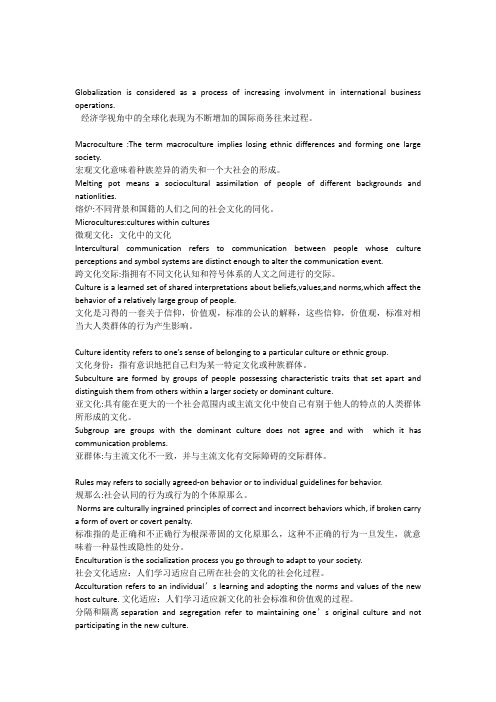
Globalization is considered as a process of increasing involvment in international business operations.经济学视角中的全球化表现为不断增加的国际商务往来过程。
Macroculture :The term macroculture implies losing ethnic differences and forming one large society.宏观文化意味着种族差异的消失和一个大社会的形成。
Melting pot means a sociocultural assimilation of people of different backgrounds and nationlities.熔炉:不同背景和国籍的人们之间的社会文化的同化。
Microcultures:cultures within cultures微观文化:文化中的文化Intercultural communication refers to communication between people whose culture perceptions and symbol systems are distinct enough to alter the communication event.跨文化交际:指拥有不同文化认知和符号体系的人文之间进行的交际。
Culture is a learned set of shared interpretations about beliefs,values,and norms,which affect the behavior of a relatively large group of people.文化是习得的一套关于信仰,价值观,标准的公认的解释,这些信仰,价值观,标准对相当大人类群体的行为产生影响。
跨文化交际名词解释

跨文化交际名词解释导语:随着全球化进程的加速,跨文化交际成为了当今社会中不可忽视的一个重要领域。
在跨文化交际中,涉及到许多专有名词。
本文将对其中一些常见的跨文化交际名词进行解释,以帮助读者更好地理解和适应跨文化交际环境。
一、文化认知(Cultural Awareness)文化认知是指对不同文化之间的差异和特点进行了解和理解的能力。
这包括对文化背景、价值观、习俗、信仰、礼仪等方面的了解。
在跨文化交际中,文化认知是跨越文化差异和潜在冲突的关键。
具备文化认知的能力可以帮助人们更好地处理和解决跨文化交际中的问题。
二、文化折衷主义(Cultural Hybridization)文化折衷主义是指不同文化之间互相吸收、交融并形成新的文化形态的过程。
在全球化的背景下,不同文化之间的互动和融合日益增多,导致了文化的折衷和更新。
文化折衷主义在跨文化交际中意味着不同文化之间的互相尊重和互动,并且在这个过程中形成更加包容和开放的态度。
三、文化霸权(Cultural Hegemony)文化霸权指的是在跨文化交际中,某一文化因其经济、政治或军事上的强势,通过文化传播手段和方式来主导其他文化的现象。
具有文化霸权意识的文化会在其他文化中产生一定程度的影响力,导致其他文化的价值观、行为方式等趋于同质化。
在跨文化交际中,要重视和避免文化霸权对于其他文化的消解和侵害。
四、文化认同(Cultural Identity)文化认同是指个体对于自己所属文化的认同感和对该文化的归属感。
在跨文化交际中,个体的文化认同既受个体内因素的影响,也受外在因素的影响。
文化认同对于个体的行为、态度和价值观有着重要影响,同时也会影响个体在跨文化交际中对其他文化的接纳程度和开放度。
五、文化冲击(Culture Shock)文化冲击是指个体在跨越文化差异的过程中,经历新文化所带来的一系列困惑、不适和认知上的障碍。
文化冲击通常分为三个阶段:初始阶段的兴奋期,接着是困惑期,最后是适应期。
《跨文化交际》名词解释

1. Globalization is considered as a process of increasing involvment in international business operations.经济学视角中的全球化表现为不断增加的国际商务往来过程。
2. Macroculture :The term macroculture implies losing ethnic differences and forming one large society.宏观文化意味着种族差异的消失和一个大社会的形成。
3. Melting pot means a sociocultural assimilation of people of different backgrounds and nationlities.熔炉:不同背景和国籍的人们之间的社会文化的同化。
4. Microcultures:cultures within cultures微观文化:文化中的文化5. Intercultural communication refers to communication between people whose culture perceptions and symbol systems are distinct enough to alter the communication event.跨文化交际:指拥有不同文化认知和符号体系的人文之间进行的交际。
Chapter 16. Culture is a learned set of shared interpretations about beliefs,values,and norms,which affect the behavior of a relatively large group of people.文化是习得的一套关于信仰,价值观,规范的公认的解释,这些信仰,价值观,规范对相当大人类群体的行为产生影响。
《跨文化交际》名词解释资料讲解

《跨文化交际》名词解释1. Globalization is considered as a process of increasing involvment in international business operations.经济学视角中的全球化表现为不断增加的国际商务往来过程。
2. Macroculture :The term macroculture implies losing ethnic differences and forming one large society.宏观文化意味着种族差异的消失和一个大社会的形成。
3. Melting pot means a sociocultural assimilation of people of different backgrounds and nationlities.熔炉:不同背景和国籍的人们之间的社会文化的同化。
4. Microcultures:cultures within cultures微观文化:文化中的文化5. Intercultural communication refers to communication between people whose culture perceptions and symbol systems are distinct enough to alter the communication event.跨文化交际:指拥有不同文化认知和符号体系的人文之间进行的交际。
Chapter 16. Culture is a learned set of shared interpretations about beliefs,values,and norms,which affect the behavior of a relatively large group of people.文化是习得的一套关于信仰,价值观,规范的公认的解释,这些信仰,价值观,规范对相当大人类群体的行为产生影响。
跨文化交际_名词解释

跨文化交际_名词解释(总3页) -本页仅作为预览文档封面,使用时请删除本页-名词解释1.Intercultural communication refers to communication between people whoseculture perceptions and symbol systems are distinct enough to alter thecommunication event.跨文化交际:指拥有不同文化认知和符号体系的人文之间进行的交际。
2.Culture is a learned set of shared interpretations about beliefs, values, andnorms, which affect the behavior of a relatively large group of people.文化是习得的一套关于信仰,价值观,规范的公认的解释,这些信仰,价值观,规范对相当大人类群体的行为产生影响。
3.Culture identity refers to one’s sense of belonging to a particular culture orethnic group.文化身份:指有意识地把自己归为某一特定文化或种族群体。
4.Subculture are formed by groups of people possessing characteristic traits thatset apart and distinguish them from others within a larger society or dominant culture.亚文化:具有能在更大的一个社会范围内或主流文化中使自己有别于他人的特点的人类群体所形成的文化。
5.Norms are culturally ingrained principles of correct and incorrect behaviorswhich, if broken carry a form of overt or covert penalty.规范指的是正确和不正确行为根深蒂固的文化原则,这种不正确的行为一旦发生,就意味着一种显性或隐性的处罚。
跨文化交际概念

跨文化交际概念“跨文化交际”的英语名称是“cross-cultural communication(或inter-cultural communication)”。
它指本族语者与非本族语者之间的交际,也指任何在语言和文化背景方面有差异的人们之间的交际。
通俗来说就是如果你和外国人打交道(由于存在语言和文化背景的差异),应该注意什么问题,应该如何得体地去交流。
从对外汉语专业的角度,“跨文化交际”的概念可以这样界定:在特定的交际情景中,具有不同的文化背景的交际者使用同一种语言(母语或目的语)进行的口语交际。
它包含以下几个要点:1.交际双方必须来自不同的文化背景文化背景的差异是一个宽泛的概念,既是指不同文化圈之间的差异,也是指同一文化圈内部亚文化之间的差异。
不过立足对外汉语专业,文化差异主要指不同文化圈之间的差异,尤其是中国和欧美国家的文化差异。
因为从跨文化交际的实际情形来看,由于文化背景的差异导致交际失误,容易引起冲突的主要是中国和欧美国家的人际交往。
中国同亚洲地区国家,如日本、韩国以及东南亚一些国家的人际交往,虽然也有文化差异的一面,但要顺利的多,这是因为这些国家与中国同属东方文化圈,彼此之间在文化取向和交际规范方面有很多相通的地方。
[1]2.交际双方必须使用同一种语言交际这是显而易见的,假如一方使用一种语言,而另一方使用另外一种不同的语言,交际是无法进行的。
但是,既然交际的双方来自不同的文化背景,又要使用同一种语言,那么用来交际的语言对一方来说是母语,而对另一方来说必然是第二语言(习得的“目的语”)。
比如一个中国人与一个美国人交谈,他们可以选择使用汉语,也可以选择使用英语,这样他们就可以用同一种语言直接交际,而不需要通过翻译这个中间环节。
这样界定的着眼点也是由对外汉语专业的特点决定的。
3.交际双方进行的是实时的口语交际跨文化交际的途径多种多样。
可以是语言符号的交际,也可以是非语言符号的交际,如商品、画报、实物、影像、演出到其他物化形式符号的交际;可以是现场的双向交际,也可以是通过媒介的单向交际,如电视、广播、报刊、广告等传播方式的交际;可以是口语交际,也可以是书面交际,如信函、公文等的来往。
跨文化交际名词解释

跨文化交际名词解释跨文化交际指的是在不同文化背景下进行的交流和互动。
在全球化的背景下,跨文化交际变得越来越重要,因为不同国家和文化之间的交流和合作已经成为现实。
以下是几个与跨文化交际相关的重要名词解释。
1. 文化冲突(Cultural Conflict):指在不同文化间发生的摩擦或冲突。
文化冲突可能源于不同的价值观、信仰、惯例、行为方式等。
通过跨文化交际,人们可以更好地理解和尊重他人的文化差异,减少文化冲突的发生。
2. 文化智商(Cultural Intelligence):指人们在跨文化环境中有效运用跨文化知识、技巧和能力的能力。
高文化智商的个体能够适应和应对不同文化之间的差异,从而更好地与其他人进行有效的跨文化交际。
3. 冷冻音(Frozen Accent):指在学习第二语言时,母语的语音习惯会影响人们发音的现象。
冷冻音是一种跨文化交际的障碍,会导致人们的发音不准确,难以被他人理解。
4. 文化微观描绘(Culture Micro-Mapping):研究人们在跨文化交际中特定情境下的行为和交际方式的方法。
文化微观描绘通过分析人们的行为习惯、价值观念、非语言交际等方面的差异,帮助人们更好地理解不同文化之间的交际模式。
5. 柔性文化 (Flexible Culture):柔性文化强调对不同文化之间的差异保持开放和灵活的态度。
在跨文化交际中,柔性文化的人们能够适应和接纳不同文化的观念和行为方式,与他人进行有效沟通和合作。
6. 文化同化(Cultural Assimilation):指在跨文化交际中,个体为了更好地适应和融入特定文化,逐渐接受并遵从目标文化的价值观、行为方式和社会规范的过程。
文化同化是跨文化交际中一个重要的适应策略。
7. 语言障碍(Language Barrier):指由于语言差异导致的交际障碍。
不同的语言系统和语言表达方式可能使人们难以理解和沟通。
在跨文化交际中,克服语言障碍是一个重要的挑战,可以通过学习对方语言和使用辅助工具等方式解决。
跨文化交际名词解释
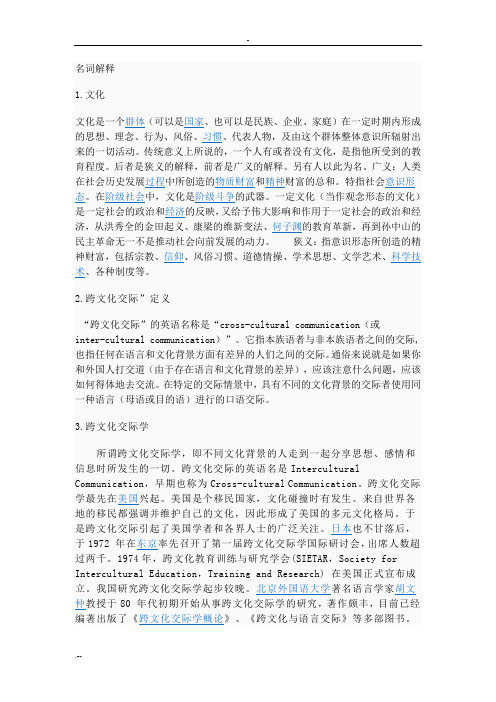
目前,跨文化交际学已发展成为一门被国际学者们充分重视的集人类学、语言学、心理学、传播学、社会学等为一体的综合性学科。
4.文化差异文化差异是由各国的历史传统以及不同的社会发展进程所产生的,表现在社会文化的各个方面。
从霍氏的各文化维度指标值中,可得出东西方的文化差异是十分明显的,就是在同为东方文化圈的中国大陆、日本、中国香港、新加坡等也是较明显的。
就如中日两国文化都是一种集体主义导向,但两种集体主义却有较大的不同。
此外,除了民族、地域文化差异之外,不可否认,还有投资合作伙伴“公司文化”的风格差异。
可以说,公司内文化差距越大,产生文化冲突与困惑的可能性与强度就会越来越大。
霍夫斯坦特对文化下了这样一个定义:所谓“文化”,是在同一个环境中的人民所具有的“共同的心理程序”。
因此,文化不是一种个体特征,而是具有相同社会经验、受过相同教育的许多人所共有的心理程序。
不同的群体,不同的国家或地区的人们,这种共有的心理程序之所以会有差异,是因为他们向来受着不同的教育、有着不同的社会和工作,从而也就有不同的思维方式。
(权力距离、不确定性避免、个人主义与集体主义、男性度与女性度、长期取向与短期取向)5、文化词,什么是文化词呢?文化词就是指蕴含社会文化意义的词语,文化意义就是指社会赋予词语的引申义、联想义、比喻义、象征义等。
文化词与民族心理、风俗习惯和社会变革等密切相关,是词汇中最活跃的部分。
文化词和其他词汇一起组成了语言的底座,与语言紧密相随,在语言中也随处可见。
通过多年的对外汉语教学我发现,对留学生的文化词教学仅仅停留在词汇的表层意义上已经不能满足学生对汉语深层意蕴的渴求,文化词教学在对外汉语教学中是一个必须面对又很难把握的环节,甚至很多老师还没有认识到文化词教学其实是对外汉语教学的一部分。
6、体态语释义:又称“身体语言”。
是用身体动作来表达情感、交流信息、说明意向的沟通手段。
包括姿态、手势、面部表情和其他非语言手段,如点头、摇头、挥手、瞪眼等。
跨文化交际》_名词解释
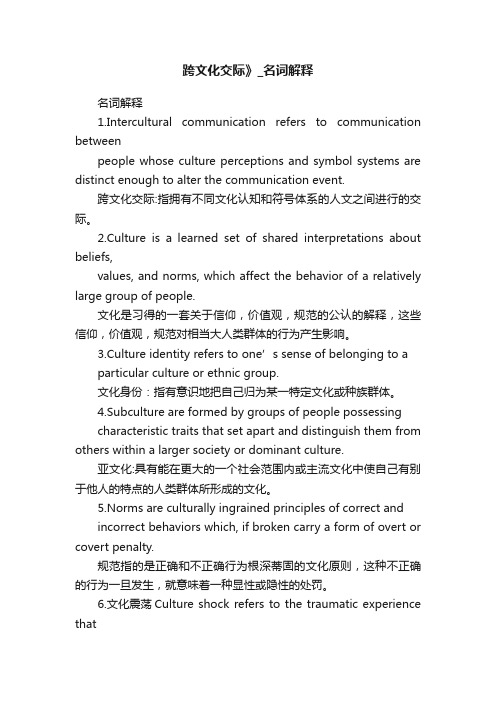
跨文化交际》_名词解释名词解释1.Intercultural communication refers to communication betweenpeople whose culture perceptions and symbol systems are distinct enough to alter the communication event.跨文化交际:指拥有不同文化认知和符号体系的人文之间进行的交际。
2.Culture is a learned set of shared interpretations about beliefs,values, and norms, which affect the behavior of a relatively large group of people.文化是习得的一套关于信仰,价值观,规范的公认的解释,这些信仰,价值观,规范对相当大人类群体的行为产生影响。
3.Culture identity refers to one’s sense of belonging to aparticular culture or ethnic group.文化身份:指有意识地把自己归为某一特定文化或种族群体。
4.Subculture are formed by groups of people possessingcharacteristic traits that set apart and distinguish them from others within a larger society or dominant culture.亚文化:具有能在更大的一个社会范围内或主流文化中使自己有别于他人的特点的人类群体所形成的文化。
5.Norms are culturally ingrained principles of correct andincorrect behaviors which, if broken carry a form of overt or covert penalty.规范指的是正确和不正确行为根深蒂固的文化原则,这种不正确的行为一旦发生,就意味着一种显性或隐性的处罚。
跨文化交际主要名词解释

1.verbal communication1.言语交际V erbal intercultural communications happens when people from different cultural backgrounds communicate with each other by using language.当来自不同文化背景的人们用语言进行交流时言语交际就发生了。
2.非言语信号:(狭义)noverbal communication refers to intertional use of non-spoken symbol to communicate a specific message .运用非言语符号传达特定信息的交际行为。
(广义)refers to elements of the environment that communicate by virtue of people’s use of them.人们交际时运用的环境因素。
municative context;Communicative context is more likely to affect our communication with those who have different culture from ours or hold our language as their second language.情境context交际发生的环境并且有助于解释交际内容的含义。
The final component of communication is context. Generally, context can be defined as the environment in which the communication takes place and which helps define the communication. It’s the information that surrounds an event, it is in extricably bound up with the meaning of the event.4.Culture is a learned set of shared interpretations about beliefs,values,and norms,which affect the behavior of a relatively large group of people.文化是习得的一套关于信仰,价值观,规范的公认的解释,这些信仰,价值观,规范对相当大人类群体的行为产生影响。
跨文化交际名词解释
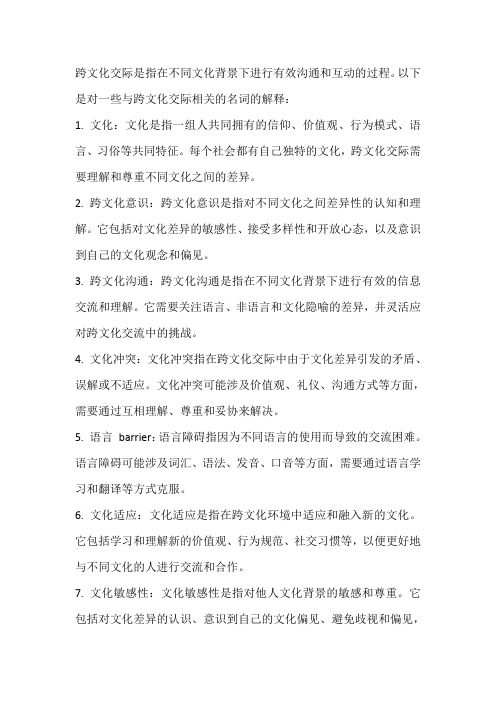
跨文化交际是指在不同文化背景下进行有效沟通和互动的过程。
以下是对一些与跨文化交际相关的名词的解释:
1. 文化:文化是指一组人共同拥有的信仰、价值观、行为模式、语言、习俗等共同特征。
每个社会都有自己独特的文化,跨文化交际需要理解和尊重不同文化之间的差异。
2. 跨文化意识:跨文化意识是指对不同文化之间差异性的认知和理解。
它包括对文化差异的敏感性、接受多样性和开放心态,以及意识到自己的文化观念和偏见。
3. 跨文化沟通:跨文化沟通是指在不同文化背景下进行有效的信息交流和理解。
它需要关注语言、非语言和文化隐喻的差异,并灵活应对跨文化交流中的挑战。
4. 文化冲突:文化冲突指在跨文化交际中由于文化差异引发的矛盾、误解或不适应。
文化冲突可能涉及价值观、礼仪、沟通方式等方面,需要通过互相理解、尊重和妥协来解决。
5. 语言barrier:语言障碍指因为不同语言的使用而导致的交流困难。
语言障碍可能涉及词汇、语法、发音、口音等方面,需要通过语言学习和翻译等方式克服。
6. 文化适应:文化适应是指在跨文化环境中适应和融入新的文化。
它包括学习和理解新的价值观、行为规范、社交习惯等,以便更好地与不同文化的人进行交流和合作。
7. 文化敏感性:文化敏感性是指对他人文化背景的敏感和尊重。
它包括对文化差异的认识、意识到自己的文化偏见、避免歧视和偏见,
并以尊重和包容的态度对待不同文化。
跨文化交际是在全球化时代中越来越重要的能力,它帮助个人和组织更好地理解和应对多元文化环境中的挑战,并促进不同文化之间的和谐与合作。
跨文化交际名词术语解释
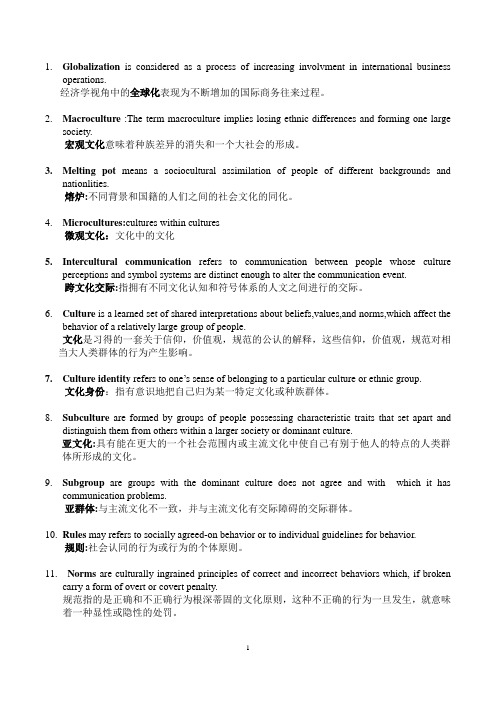
1.Globalization is considered as a process of increasing involvment in international businessoperations.经济学视角中的全球化表现为不断增加的国际商务往来过程。
2.Macroculture :The term macroculture implies losing ethnic differences and forming one largesociety.宏观文化意味着种族差异的消失和一个大社会的形成。
3.Melting pot means a sociocultural assimilation of people of different backgrounds andnationlities.熔炉:不同背景和国籍的人们之间的社会文化的同化。
4.Microcultures:cultures within cultures微观文化:文化中的文化5.Intercultural communication refers to communication between people whose cultureperceptions and symbol systems are distinct enough to alter the communication event.跨文化交际:指拥有不同文化认知和符号体系的人文之间进行的交际。
6.Culture is a learned set of shared interpretations about beliefs,values,and norms,which affect thebehavior of a relatively large group of people.文化是习得的一套关于信仰,价值观,规范的公认的解释,这些信仰,价值观,规范对相当大人类群体的行为产生影响。
跨文化交际 名词解释

Introduction1.Globalization is considered as a process of increasing involvment ininternational business operations.经济学视角中的全球化表现为不断增加的国际商务往来过程。
2.Macroculture:The term macroculture implies losing ethnic differences andforming one large society.宏观文化意味着种族差异的消失和一个大社会的形成。
3.Melting pot means a sociocultural assimilation of people of differentbackgrounds and nationlities.熔炉:不同背景和国籍的人们之间的社会文化的同化。
4.Microcultures:cultures within cultures微观文化:文化中的文化5.Intercultural communication refers to communication between people whoseculture perceptions and symbol systems are distinct enough to alter the communication event.跨文化交际:指拥有不同文化认知和符号体系的人文之间进行的交际。
Chapter 16.Culture is a learned set of shared interpretations about beliefs,values,andnorms,which affect the behavior of a relatively large group of people.文化是习得的一套关于信仰,价值观,规范的公认的解释,这些信仰,价值观,规范对相当大人类群体的行为产生影响。
跨文化交际名词解释汇总

跨文化交际名词解释汇总
跨文化交际(Intercultural Communication)是指不同文化之间进行的交际活动。
在跨文化交际中,涉及到许多名词和概念。
以下是对一些常见的跨文化交际名词的解释:
1.文化(Culture):文化是人类社会的一种现象,包括人类所共同创造的一切物质和非物质的事物,如语言、宗教、价值观念、习俗等。
2.文化冲突(Culture Clash):指不同文化之间的价值、信仰、行为方式等存在差异,导致交流过程中产生的冲突。
3.文化认知(Cultural Awareness):指人们对不同文化的理解、认识和感知。
4.跨文化交际能力(Intercultural Communication Competence):指具备有效应对跨文化交际的能力,包括对不同文化的理解、适应和应对。
5.文化智商(Cultural Intelligence):指人们在跨文化交际中应对复杂情境的能力,包括对文化差异的认知、理解和应对能力。
6.文化适应(Culture Adaptation):指在新的文化环境中,个体逐渐适应并接受该文化的过程。
7.文化刻板印象(Cultural Stereotype):指对某一文化或文化群体的普遍化、片面化的看法和评价。
8.文化代际冲突(Intergenerational Culture Conflict):指不同世代之间在文化、价值观念等方面的差异导致的冲突。
9.文化霸权(Cultural Hegemony):指某一特定文化在全球范围内的主导地位。
以上是一些常见的跨文化交际名词的解释。
在跨文化交际中,了解这些名词的含义对于有效的跨文化交际至关重要。
《跨文化交际》_名词解释

名词解释1.Intercultural communication refers to communication between people whoseculture perceptions and symbol systems are distinct enough to alter thecommunication event.跨文化交际:指拥有不同文化认知和符号体系的人文之间进行的交际。
Culture is a learned set of shared interpretations about beliefs, values, and norms, which affect the behavior of a relatively large group of people.文化是习得的一套关于信仰,价值观,规范的公认的解释,这些信仰,价值观,规范对相当大人类群体的行为产生影响。
Culture identity refers to one’s sense of belonging to a particular culture or ethnic group.文化身份:指有意识地把自己归为某一特定文化或种族群体。
Subculture are formed by groups of people possessing characteristic traits that set apart and distinguish them from others within a larger society or dominant culture.亚文化:具有能在更大的一个社会范围内或主流文化中使自己有别于他人的特点的人类群体所形成的文化。
Norms are culturally ingrained principles of correct and incorrect behaviors which, if broken carry a form of overt or covert penalty.规范指的是正确和不正确行为根深蒂固的文化原则,这种不正确的行为一旦发生,就意味着一种显性或隐性的处罚。
跨文化交际名词解释(3)
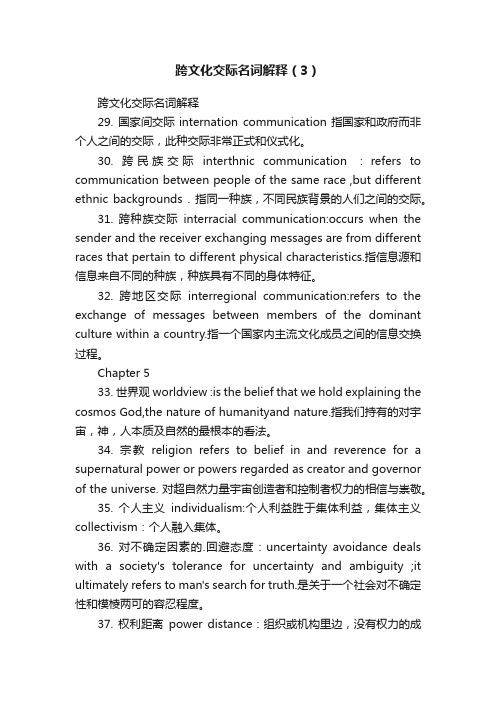
跨文化交际名词解释(3)跨文化交际名词解释29. 国家间交际internation communication指国家和政府而非个人之间的交际,此种交际非常正式和仪式化。
30. 跨民族交际interthnic communication :refers to communication between people of the same race ,but different ethnic backgrounds . 指同一种族,不同民族背景的人们之间的交际。
31. 跨种族交际interracial communication:occurs when the sender and the receiver exchanging messages are from different races that pertain to different physical characteristics.指信息源和信息来自不同的种族,种族具有不同的身体特征。
32. 跨地区交际interregional communication:refers to the exchange of messages between members of the dominant culture within a country.指一个国家内主流文化成员之间的信息交换过程。
Chapter 533. 世界观worldview :is the belief that we hold explaining the cosmos God,the nature of humanityand nature.指我们持有的对宇宙,神,人本质及自然的最根本的看法。
34. 宗教religion refers to belief in and reverence for a supernatural power or powers regarded as creator and governor of the universe. 对超自然力量宇宙创造者和控制者权力的相信与崇敬。
(完整版)《跨文化交际》名词解释

Introduction1.Globalization is considered as a process of increasing involvment in international businessoperations.经济学视角中的全球化表现为不断增加的国际商务往来过程。
2.Macroculture:The term macroculture implies losing ethnic differences and forming onelarge society.宏观文化意味着种族差异的消失和一个大社会的形成。
3.Melting pot means a sociocultural assimilation of people of different backgrounds andnationlities.熔炉:不同背景和国籍的人们之间的社会文化的同化。
4.Microcultures:cultures within cultures微观文化:文化中的文化5.Intercultural communication refers to communication between people whose cultureperceptions and symbol systems are distinct enough to alter the communication event.跨文化交际:指拥有不同文化认知和符号体系的人文之间进行的交际。
Chapter 16.Culture is a learned set of shared interpretations about beliefs,values,and norms,which affectthe behavior of a relatively large group of people.文化是习得的一套关于信仰,价值观,规范的公认的解释,这些信仰,价值观,规范对相当大人类群体的行为产生影响。
什么是跨文化交际

什么是跨文化交际?跨文化交际是什么?所谓跨文化交际,即不同文化背景的人走到一起分享思想、感情和信息时所发生的一切。
跨文化交际的英语名是Intercultural munication,早期也称为Cross-cultural munication。
跨文化交际学最先在美国兴起。
美国是个移民国家,文化碰撞时有发生。
来自世界各地的移民都强调并维护自己的文化,因此形成了美国的多元文化格局。
于是跨文化交际引起了美国学者和各界人士的广泛关注。
日本也不甘落后,于1972年在东京率先召开了第一届跨文化交际学国际研讨会,出席人数超过两千。
1974年,跨文化教育训练与研究学会(SIETAR,Society for Intercultural Education,Training and Research)在美国正式宣布成立。
我国研究跨文化交际学起步较晚。
北京外国语大学著名语言学家胡文仲教授于80年代初期开始从事跨文化交际学的研究,著作颇丰,目前已经编著出版了《跨文化交际学概论》跨文化与语言交际》等多部图书。
目前,跨文化交际学已发展成为一门被国际学者们充分重视的集人类学、语言学、心理学、传播学、社会学等为一体的综合性学科。
什么是跨文化交际能力就是拥有能够和你不同文化的人进行正常有效沟通的能力啊。
比如和其他国家的人,或者其他民族的人交流,你们生活的地域不同,文化也不同,风俗习惯不同,思考方式自然也不同。
比如同样的手势,在不同的文化中可能代表截然相反的概念。
这就要求交流者同时了解这两种文化的背景,才能进行有效的沟通。
跨文化交际的内容简介《跨文化交际》是“新编研究生英语系列教材”之一。
本系列教材是外教社组织国内10余所重点高校的专家、教授,在广泛的市场调研和对当前研究生英语教学实际情况进行详细分析的基础上,倾力打造而成,以满足新时期人才培养的需要,和多样化、个性化的学习需求。
跨文化交际的内容简介改革开放以来,中国发生了翻天覆地的变化,国际化”与国际接轨”这样的字眼,已在中国广泛使用。
跨文化交际名词解释(3)

跨文化交际名词解释(3)跨文化交际名词解释29. 国家间交际internation communication指国家和政府而非个人之间的交际,此种交际非常正式和仪式化。
30. 跨民族交际interthnic communication :refers to communication between people of the same race ,but different ethnic backgrounds . 指同一种族,不同民族背景的人们之间的交际。
31. 跨种族交际interracial communication:occurs when the sender and the receiver exchanging messages are from different races that pertain to different physical characteristics.指信息源和信息来自不同的种族,种族具有不同的身体特征。
32. 跨地区交际interregional communication:refers to the exchange of messages between members of the dominant culture within a country.指一个国家内主流文化成员之间的信息交换过程。
Chapter 533. 世界观worldview :is the belief that we hold explaining the cosmos God,the nature of humanityand nature.指我们持有的对宇宙,神,人本质及自然的最根本的看法。
34. 宗教religion refers to belief in and reverence for a supernatural power or powers regarded as creator and governor of the universe. 对超自然力量宇宙创造者和控制者权力的相信与崇敬。
- 1、下载文档前请自行甄别文档内容的完整性,平台不提供额外的编辑、内容补充、找答案等附加服务。
- 2、"仅部分预览"的文档,不可在线预览部分如存在完整性等问题,可反馈申请退款(可完整预览的文档不适用该条件!)。
- 3、如文档侵犯您的权益,请联系客服反馈,我们会尽快为您处理(人工客服工作时间:9:00-18:30)。
Define the following terms:
1.Culture: it refers to a learned set of shared interpretations about
beliefs, values, norms and social practices, which affect the
behaviors of a relatively large group of people.
2.Intercultural communication: It is communication between
people from different cultural backgrounds, or it refers to
communication between people whose cultural perceptions and symbol systems are distinct enough to alter the communication event.
3.Denotative meaning tends to be described as the definitional,
literal, obvious or commonsense meaning of a word.
4.Connotative meaning is used to refer to the socio-cultural
associations of the word.
5.In case of inductive reasoning, one stores a number of
specific instances and induces a general law or rule or
conclusion that governs or subsumes the specific instances. 6.Deductive reasoning is a movement from a generalization to
specific instances: specific subsumed facts are inferred or
deduced from a general principle.
7.Analytical thinking patterns:analyze and dissect things into
elements in order to understand them properly. The emphasis is upon the parts rather than the whole of things.
8.Synthetic thinking patterns:synthesize elements into a unit,
with the emphasis on the “whole”.
9.Verbal Communication:refers to communication done
both orally and in written language
10.Linguistic Determinism: is the idea that language and its
structures limit and determine human knowledge or thought. 11.Linguistic Relativity: holds that the structure of a language
affects the ways in which its speakers are able to conceptualize their world.
12.Nonverbal Communication:involves all nonverbal stimuli in a
communication setting that is generated by both the source and his or her use of the environment and that has potential message value for the source or receiver.
13.Body language:refers to all nonverbal codes which are
associated with body movements. It includes gestures, head
movements, facial expressions, eye behaviors, postures and other displays that can be used to communicate.
14.Monochronic time (M Time):It schedules one event at a time.
In these cultures time is perceived as a linear structure just like a ribbon stretching from the past into the future.
15.Polychronic time (P Time):It schedules several activities at the
same time. In these culture people emphasize the involvement of people more than schedules. They do not see appointments as
ironclad commitments and often break them.
16.Taboo refers to some words or actions that are avoided by a
particular group of people,or in certain for religious or social reasons.
17.Euphemism means the act of substituting a mild, indirect, or
vague term for one considered harsh, blunt, or offensive.
18.Paralanguage refers to the rate, pitch and volume qualities of
the voice, which interrupt or temporarily take the place of speech and affect the meaning of a message.
19.Individual culture: individuals tend to define themselves by the
extent to which they are different from, rather than similar to
others. People are encouraged to display self-confidence and
assertiveness, disclosure of personal thoughts and feelings.
20.Collectivist culture: place little value on individual identity and
great value on group identity. It has been labeled as “we” culture because basic unit is the in-group or collective.。
